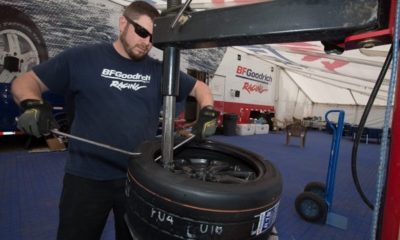Racing tires are a wonderful thing – nice and sticky, they allow more of those things that all racers crave – g-forces and speed. What they don’t afford, however, is long life. Since racers measure the cost of most things in the number of tires one could buy with the same money, it’s clear that getting as much life out of a set is a worthwhile goal. Fortunately, there are some things a driver can do to make sure that they get as many races as possible on a set of rubber.
“There are some simple things that help, like where do you store your tires?” says BFGoodrich® Tires Motorsports Technical Director Ken Payne. “If you’re in a part of the country where it gets extremely hot in the summer, for example, probably the worst place you can store those tires is in your enclosed trailer or on the tire rack of your open trailer. A cool, dry, dark place with no direct sunlight is really the best place to store your tires. If you have a basement, that’s great. I use the crawl space under my house, which has a pretty high ceiling level. If I know I’m not going to turn them around in a week or so, I stuff them into the crawl space in some black plastic trash bags.”
Storage is the most basic consideration, but there are some other tips and tricks that can help tire longevity and maintain grip level, aside from not sliding around, locking up the brakes or spinning the drive tires out of every corner.
“It’s not bad on many tires if you have the opportunity to do a moderate heat cycle the first time you use them; that can often be beneficial in extending the tire life. The first session, work them a little bit, but not extremely hard. Get the temperature up, exercise them some and let them cool off. All tires are a complex composite structure. You’ve got stresses that are built in when the tires are constructed. That first cycle of temperature dynamic loading helps essentially equilibrate and relieve a lot of those inherent stresses that are in the tire from the manufacturing process,” Payne explains.
Finally, consider setup. While your wheel alignments may be perfect for the best lap times, there is always a trade-off – you may be sacrificing a race or two from your tires.
“Toe setting is one of those things that can be particularly significant in terms of maximum tire life,” says Payne. “We’ll have some folks that do a lot of toe out to make that initial turn-in response a little sharper. In an autocross, where you don’t have long straights, that might be perfectly fine. But on a road course, particularly one where you have a long straight, that extra toe out is dragging the tire slightly sideways down the pavement when it’s not turning, and that can produce some adverse wear. Likewise at the rear, a little toe in helps stability on a lot of cars; but that little bit can be too much sometimes. That’s where both looking at wear aspects and looking at tire temperatures can be really helpful to find the optimum settings for your car from both a performance and wear life standpoint.”


 ACCESSIBILITY
ACCESSIBILITY